Share
Working at ESO
Are you interested in working in areas of frontline technology and in a stimulating international environment? Do you feel your profile matches our requirements? Learn more about our current vacancies and apply online. Read more..
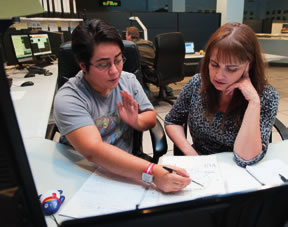
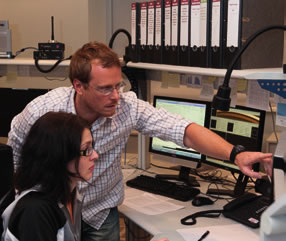
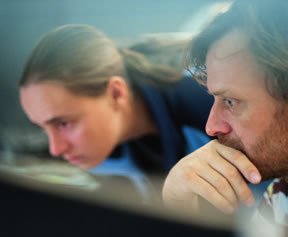
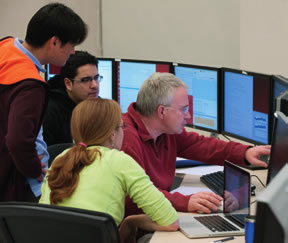

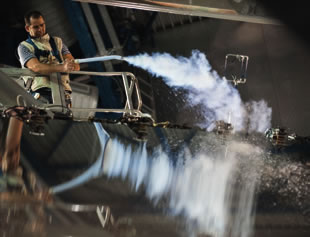
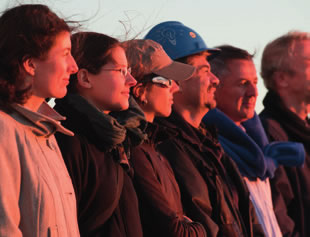
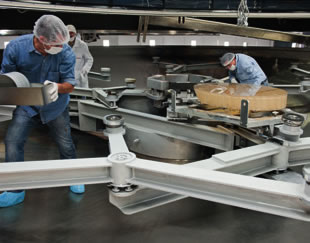
The European Organisation for Astronomical Research in the Southern Hemisphere (ESO) is the foremost intergovernmental astronomy organisation in Europe and the world's most productive ground-based astronomical observatory. ESO carries out an ambitious programme focused on the design, construction and operation of powerful ground-based observing facilities enabling astronomers to make important scientific discoveries.
ESO operates three unique world-class observing sites in northern Chile: La Silla, Paranal and Chajnantor (home to ALMA and APEX), and the ESO Headquarters are located in Garching, near Munich, Germany.
At Paranal, ESO operates the Very Large Telescope, the world's most advanced visible-light astronomical observatory, and will host and operate the southern array of the Cherenkov Telescope Array, the world's largest and most sensitive high energy gamma-ray observatory. ESO is a major partner in ALMA, the largest astronomical project in existence. And on Cerro Armazones, ESO is building the 39-metre Extremely Large Telescope (ELT), which will become "the world's biggest eye on the sky" and whose operations will be fully integrated into the Paranal Observatory.
For its Maintenance, Support and Engineering Department (MSE), and for its Science Operations Department (PSO) at Paranal Observatory, ESO is inviting students from Chilean universities to participate in our program:
Summer Students Chile 2021
Paranal
Deadline 12/10/2020
Every year ESO offers internship projects for students from Chilean universities seeking professional practice during the months of January and February. The projects offered are for the areas of Maintenance, Support and Engineering Department (MSE), and Science Operations Department (PSO) at Paranal Observatory.
The Maintenance, Support and Engineering (MSE) Department of the Paranal Observatory ensures technical availability of the four VLT 8m telescopes, the two survey telescopes (VST and VISTA), the VLT interferometer with its auxiliary telescopes, many complex instruments for scientific observations and common facilities (power production, chillers and three coating units). The MSE Department of Paranal has a total workforce of about 60 engineers and 25 technicians, distributed in six groups (Systems and Optics, Electronics, Mechanics, Software, Instrumentation, and Support and Quality Assurance).
The Paranal Science Operations Department (PSO) is responsible for the execution of all scheduled observations and the production of astronomical data of highest quality. PSO is charged to maintain and whenever possible improve the scientific and operational performances of the Paranal telescopes and instruments. Science operations support is provided to the four VLT 8-m telescopes, to the VLT Interferometer with its auxiliary telescopes, the VLT survey telescopes, and to all instruments available for scientific observations. PSO has a total workforce of 40 astronomers and 25 engineers.
The Maintenance, Support and Engineering (MSE) Department offers the following six projects the period January-February 2021:
1. 4LGSF log data analysis
This internship focus on the multiple laser systems used at Paranal for the adaptive Optics. The work consists in extracting logs from PLC and computers, send them to a central datalake and automate data analysis to look at performance and faults.
Objective:
- Correlate data with operational events to help with predictive maintenance
- Automate data analysis or download of logs
Student profile:
- Last years of Engineering, computational science, physics or mathematics
- Knowledge and experience in Data analysis
- Knowledge and experience in Python and Pandas
- Basic knowledge in Physics
- Strong motivation to work in data analysis with real data
Host: MSE Dpt, Instrumentation Group.
2. Thermographic camera for telescope maintenance
This projects is aimed at cooling problem detection in particular in electronic racks. The internship focuses on getting practice and be familiar with the IoT technology using a small thermal camera to be deployed in the field in our telescopes for maintenance purpose.
Objective:
- Get familiar with the HW/SW and existing experiment
- Automate data collection and analysis to provide information for predictive maintenance.
- Test and validate in the field
Student profile: Electronics or Software Engineer student, knowledge of data analysis.
Host: MSE Dpt, Electronics engineering Group.
3. Modelling of hydraulic and pneumatic circuits with Fluidsim
The as-built documentation associated with the hydraulic and pneumatic circuits of the equipment at Paranal is not in CAD format and should be checked against the installations. Moreover, in order to simulate the behavior of the circuits, we would like to import the hydraulic and pneumatic diagrams in the software FLUIDSIM that permits to help the troubleshooting and optimization of the equipment behavior.
Objectives: Produce reliable hydraulic and pneumatic diagrams of the most critical equipment (for example M1 carriage and M1 handling tool) in order to upload them in our documentation system (PDM) and to have the relevant model available in FLUIDSI M for analysis and optimization purpose.
Student profile: Mechanical engineer, with specific knowledge of hydraulic and pneumatic diagrams, ideally knowledgeable on FLUIDSIM software.
Host: MSE Dpt, Mechanical engineering Group.
4. TCS Commissioning procedures update
Commissioning and test procedures are used to evaluate the TCS system performance and to adjust some control parameters. The use of a modern programming language (Python) in conjunction with the core of the ELT Sequencer will allow to tackle the main problems of the current implementation(s), i.e. they require too much human supervision and expert knowledge to evaluate results. The internship will focus on modernizing and automating existing telescope test procedures.
Objectives:
- Modernize TCS' commissioning and test procedures in Python
- Improve error handling
- Automate even more to drastically reduce human intervention
- Reduce the needs for expert knowledge while simply executing procedures.
Student profile: Computing student, strong knowledge of Python and Linux in general.
Host: MSE Dpt, SW group.
5. Implementation of KPI in MAXIMO
In the frame of the improvements for Planning with MAXIMO, the focus of the internship will be the implementation of the module KPI's (Key Performance Indicators) in the Start center of the tool using data available. We aim at defining a standard process to create these KPIs and customize according to MAXIMO users requests.
Objectives:
- Collect documentation and procedures how to implement Maximo KPI's
- Define in agreement with ESO supervisor the basics KPI's requested that must be implemented.
- Develop the process.
- Implement KPI's in the App. Maximo development
- Document the process to create and implement KPI's
- Deliver a report about what was done (problems, steps, benefits, recommendations)
- Provide a presentation to SQA group and other stakeholders
Student profile:
- Student of industrial, mechanical or software engineering of the last year of career, preferable.
- Good command in English.
- Knowledge in SQL data base.
- Knowledge previous experience on any CMMS.
- Knowledge in KPI and Dashboard.
Host: MSE Dpt, Support and Quality Assurance group.
6. Monitoring system for the Paranal technical data framework
Problems affecting the uptime of the Paranal technical data framework happens and as the system keeps growing the complexity keeps growing (Local database, data collectors, cloud system, etc.). Keep good track of these systems and their metrics is essential to understand the system to prevent and find the root causes of problems and could even help to prevent problems sending alarms before the system goes critical. Monitoring systems are in charge of collecting metrics from systems in Paranal. Monitoring systems collects as many metrics as they can, but as they collect too many metrics it is difficult to find and understand then in a useful manner, hence preventing and debugging unexpected behaviors takes time and not always delivers the results we would like.
Objectives:
- Have a good selection of metrics, pre-defined dashboards and alarm systems to help to decrease the debugging time, prevent problems with preventive maintenance, and notify administrators of problems as soon as they happen, reducing the downtime of the system.
- Select relevant monitoring metrics for current systems either cloud or local.
- Create relevant dashboards for the selected features
- Configure alerts
Student profile:
- Computer engineering/science student
- Good knowledge of Linux
- Knowledge and understanding of Docker, Databases and monitoring systems (such as Grafana, Cassandra, ElasticSearch, Prometheus and KairosDB)
Host: MSE Dpt, SW group.
References for MSE Dpt: http://www.eso.org/sci/facilities/paranal/paranalenginternship.html
The Paranal Science Operations Department (PSO) offers the following eight projects the period January-February 2021:
1. Data validation of new Paranal Vaisala sensors
The Vaisala sensors of environmental conditions are at the core of telescopes and instruments operations. Wrong measurements would affect the operations by introducing failures into the systems (pressure jumps as example) or the operations themselves (wind speed for instance). Accurate measurements are also needed to plan and proceed with the day (e.g. work in height, work on the platform) and night operations (observing strategy, pointing restriction). We recently installed a new set of sensors and they are running in parallel with the current sensors. To help with the future ramp-up and long-term improvement of the operations, it is a good time to assess the functionality of the new Vaisala sensors values along with their accuracy and reliability.
Objectives: this work will contribute to certify the functionality of the new set of meteorological sensors. Specifics deliverables are:
- Summary of the statistics of each sensor, in each set of sensors: namely, mean, standard deviation, as well as a statistical percentile in the range 0.5 through 99.5%
- Provide the probability density functions and cumulative functions for each sensor using the whole common period data series.
- Identify the occurrence of outliers.
- Validate the orientation of the wind direction sensors. Compute the mean value of the wind direction offset, if any.
Student profile:
- A student with a strong background in math (statistics), data analysis and already efficient in scripting is required.
- Interest in atmospheric physics is an asset.
2. SCUBA development and testing
SCUBA is a Python software that serves as a framework for Quality Control of astronomical data observed during the night. It aims at interfacing with every instrument at the VLT to provide near real time assessment of the quality of the observations. As such, it is quickly becoming a major tool for night-time operations. The selected intern will help us with the core part of SCUBA.
Objectives: We propose two possible trajectories for this internship (depending on experience of the intern):
- Development: Developing some core functionalities that are still missing.
- Testing: While the inner part of the core code of SCUBA is fully testable, we did not have time to start the tests on the GUI. The intern will help us writing these tests and their detailed documentation.
- Deliverables: development: modules for the targeted functionalities with their testing and documentation.
- Testing: The full testing procedure and documentation of the major panels of SCUBA.
Student profile:
- Advanced level of python programming language with experience in object-oriented programming.
- Experience with PyQT GUI development is a plus.
- Basic knowledge of astronomical observations and different techniques is an asset, as is understanding of metrics used to certify data quality.
3. Implementation of SCUBA for Gravity at the VLTI
Quality control of scientific data on site (QC0) is a fundamental part of Paranal Science Operations as well as the Integrated Operations Project (IOP), as it ensures that the data obtained with the telescopes fulfil the scientific needs. Observations are classified according to QC0 rules. At the VLTI and specifically for GRAVITY, the quality control of night-time data has so far been implemented in the so-called MONITOR script, a package of scripts providing the necessary QC0 for all VLTI instruments. The package includes visual displays and suggestions for the quality grading of observations. SCUBA on the other hand is the Master software of SciOps designed as a uniform platform to perform the QC0 tasks. It implements, for each instrument, dedicated panels that are used during the day or the night to check the quality of the data and the data analysis. This project has the goal to implement GRAVITY's QC0 in SCUBA, as a crucial first step for porting the whole VLTI functionality of the MONITOR script to SCUBA. The result will have a high impact on VLTI science operations. Once the implementation of GRAVITY QC0 is finished, the other VLTI instruments can be integrated easily making use of the same building blocks of the QC script. There is a very high synergy between the QC for the different VLTI instruments. VLTI science operation will then be in line with the QC procedures on other telescopes.
Objectives: The student is expected to re-code the GRAVITY QC0 parts of the MONITOR script complying with the SCUBA rules. This will then allow an easy implementation of the script into SCUBA. The new code has to follow the GRAVITY QC0 implementation design and its top-Level Requirements.
Student profile:
- Advanced level of python programming language.
- Basic knowledge of astronomical observations and interferometric techniques is an asset.
4. PIWI: a Paranal Interactive Widget
Reduction pipelines are a powerful tool to process data obtained with ESO facilities. Yet pipeline workflows lack of interactivity functions that would smooth, boost and make robust the use of pipeline recipes and their products. Aim of this project is to develop an interactive widget (PIWI) that displays the results of pipeline recipes and allows the user to easily modify the recipe parameters via mouse inputs, while maintaining all the functionalities of ESO workflows.
Objectives:
- The intern is expected to develop an interactive widget to support pipeline workflows through inputs into the plots displayed in Python interactive windows of ESO pipeline workflows. To comply with ESO workflow functionalities, is shall use matplotlib and wxPython.
- Implement possible bug fixing and minor changes based on feedback provided by commissioning.
Student profile:
- Undergrad Student in Computer Engineering.
- Advanced knowledge of Python programming.
- Experience with cross-platform GUI toolkit for Python (wxPython) is a plus.
- Basic knowledge of astronomical data processing is an asset.
5. Automated acquisition with FORS2 and X-Shooter: a concept study
The time spent on human interaction required for interactive instrument acquisition for spectroscopy can be considerable, and it constitutes an interruption to an otherwise continuous sequence of observing. The current project proposes a concept study to investigate how accurately automatic acquisition can be achieved. This concept study starts with two instruments in slit mode: FORS2 (LSS) and X-shooter (SLT/IFU). Both instruments have a reasonably large field of view (FOV), facilitating the suggested solution (see below) to automate instrument acquisition. They are also two of the workhorse instruments within the VLT suite, meaning that the largest gains could be made in terms of returning telescope overheads to open shutter time.
Objectives: The project deliverables are the following:
- A python code that matches fits (astronomical acquisition image) and jpeg images (finder chart), calculating offsets in an iterative fashion, giving an RMS dispersion of star positions for the final match.
- Apply such a code to around 100 (TBD) archival acquisition and finder images (Gaia) of both FORS2 and X-shooter, i.e. real data obtained at the observatory and finding charts created with ESO's tool p2fc, giving a final RMS for each match.
- Provide statistics from the application of the code to many images as listed in 2) that outline the accuracy, robustness, and utility of applying such an automatic acquisition technique to these instrument modes.
- If robust enough, this code and technique would act as a prototype application to be used for automated acquisition on as many VLT instrument modes as possible.
Student profile:
- Advanced level of python programming language.
- Basic knowledge of optical astronomical observations is an asset.
6. SPHERE Quality Control Script development
Quality control of SPHERE data is currently based on seeing and coherence time measured by the Atmospheric Site Monitoring devices, which have been shown to not always be correlated with the achieved contrast, the metric most important to the vast majority of SPHERE users. To improve our prediction of SPHERE contrast, we have developed an empirical contrast model that maps environmental conditions and relevant telescope and target parameters to the achieved contrast. A version of this model is going to be incorporated into the SPHERE exposure time calculator. SPHERE QC0 will incorporate the predicted contrast that the user anticipates based on their specified constraints and target properties supplied to the ETC, in addition to the existing criteria used to assess OBs. To assess performance relative to the ETC prediction we need to develop a QC script (within the SCUBA framework) that can compare in real-time the contrast achieved against the prediction using the ETC model. This will help minimize time spent on OBs observed under their nominal constraints where the predicted contrast was not met.
Objectives: The QC script will consist of several modules to:
- Read pipeline reduced IRDIS data (or perform a "quick look" reduction using appropriate calibration files if necessary), with logic to correctly pair flux (where the star is not occulted) and coronagraphic images.
- Measure contrast in coronagraphic images and generate plots of contrast vs. separation
- Query OB constraints and target parameters and generate ETC prediction
- Generate a plot of contrast at a nominal separation vs. time so performance degradation can be easily identified.
- Score the OB based on whether a specific fraction of the images exceeded the ETC prediction (several of these functionalities are already available in existing code and will be re-used where possible)
(Stretched goal) for the OB selection/suggestion script:
- Provide a real-time indicator of the current atmospheric turbulence parameters (TCAT)
- Query ASM and other telescope parameters to generate predicted contrast curves for targets of a range of brightness.
- Generate "equivalent" TCATs for each magnitude bin incorporating additional parameters that are correlated with contrast (e.g., M1-M2 temperature difference) to help the short-term scheduling of OBs.
Student profile:
- Advanced level of python programming language.
- Basic knowledge of astronomical observations, in particular high-contrast imaging, is an asset.
7. Quantify the operational gain by nowcasting optical turbulence
The main goal of the project is to qualify the operational gain by implementing an optical turbulence nowcast (=short-term forecast) to science operations using historical turbulence ('seeing') data. ESO and Microsoft are currently working on an optical turbulence nowcast project using machine learning (ML) algorithms. By the end of the year, the optical turbulence nowcast project is expected to provide a robust prediction on the seeing and other optical turbulence parameters in the next two hours period. During the night this nowcast should be used to select the most suitable observation to do next. The metric to optimize the ML is to compare the RMSE between the predicted seeing and measured seeing. However, such statistical metric cannot be straightforwardly transferred into a measure of an operational gain in the science operations. In this project, we will simulate on the order 10000 observations to quantify how the nowcast will improve the efficiency of our science operations compared to the standard approach of selecting observations which considers only the current conditions. This project will provide an important guideline on how to use the nowcast results for night-time operations and short-term scheduling .
Objectives: The project deliverables are to quantify the following metrics:
a) How often the "standard criteria" made a correct assessment of which science observation to run.
b) How often the "nowcast criteria" made a correct assessment of which science observation to run.
c) What fraction of the occasions both criteria agreed.
d) What fraction only the "standard criteria" was right.
e) What fraction only the "nowcast criteria" was right.
f) What fraction of the time neither criteria are able to predict the right seeing.
g) How do those fractions depend on seeing conditions (e.g. during excellent, average, bad conditions).
h) [stretch goal] How could we potentially combine the "standard criteria" and "nowcast criteria" information, to improve our science operation efficiency even further?
Student profile:
- Advanced level of python programming language.
- Basic knowledge of astronomical observations and relevant atmospheric conditions.
- Experience in machine learning is an asset.
8. Exploring Machine Learning techniques for MUSE quality control
MUSE is one of the most sophisticated instruments on board of 8m-class telescopes around the world, capable of delivering images with HST-like resolution, possible thanks to the AO module GALACSI. MUSE can be considered as a set of 1152 semi-independent 2D spectrographs. Due to the massive amount of data, visual inspection of all data products is unrealistic, making it necessary to look for ways to automatize the quality control of calibration and scientific data. Data science and machine learning provides tools that make it feasible to automatize some of the quality control processes. These techniques are complex and varied requiring a steep learning curve. This project is an opportunity for learning and strengthening of a data science culture within Paranal Science Operations. The project is split in two, requiring two students:
a) Explore machine learning techniques for improving quality control of daytime calibration data. b) Explore machine learning techniques for measuring image quality in on-sky images without stellar sources.
Objectives:
- The project deliverable is a report describing the tests performed and the feasibility to use machine learning techniques in regular operations, for both daytime calibrations and on sky observations.
- The project will draw upon first experience that ESO staff gained in applying such machine learning techniques to data of UVES, another VLT instrument.
Student profile:
- Both projects require an excellent level of python programming language and a high motivation for innovative, exploratory projects. In detail, the two students should have the following profiles: a) Proven experience with machine learning and strong data science background. Knowledge of astronomical observations and adaptive optics are desirable. b) Proven experience with astronomical image analysis and processing. Experience with machine learning and data science are desirable.
We Offer:
ESO offers a special allowance during the period you are performing your internship with us; transportation arrangements (plane tickets) from and to Santiago are provided by ESO, with accommodation provided on site. The Duty Station is Paranal Observatory, in the II Region, 120km South of Antofagasta. Work in the Vitacura offices is also possible and foreseen in some cases, depending on the nature of the project.
The period of the internship is January-February 2021.
Application:
We invite all students from Chilean Universities in an advanced stage of their career to apply. The apprenticeship should be supported by the University and therefore covered by the accident insurance (Law 16.744).
If you are interested in working in areas of frontline technology and in a stimulating international environment, you are invited to apply online at http://recruitment.eso.org/. Applications must be completed in English and should include a CV and a motivational letter indicating the project(s) you are interested to apply.
Closing date for applications is 12 October 2020.
The post is equally open to suitably qualified candidates irrespective of gender, age, disability, sexual orientation, race or religion.
